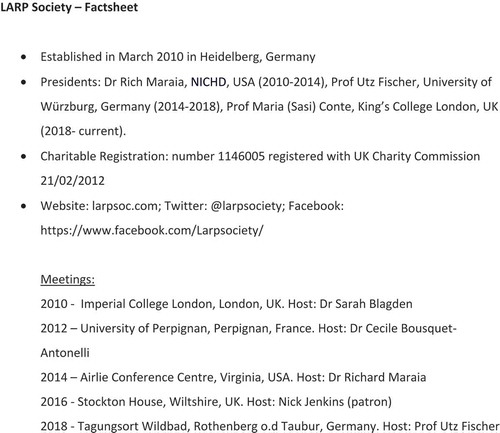This special issue of RNA Biology is devoted to the La-related family of proteins (LARPs) and celebrates the 10th Anniversary of The LARP Society (colloquially known as LARPSOC). LARP Society, not to be confused with Live Action Role Play and other historical re-enactment clubs, was formed in March 2010 by Dr Cecile Bousquet-Antonelli and Dr Sarah Blagden after a chance meeting at the EMBL ‘Complex Life of mRNA’ conference in Heidelberg, Germany (see Factsheet ). One year previously, Cecile and her colleague Professor Jean-Marc Deragon had published ‘A comprehensive analysis of the La-motif protein superfamily’ which provided a curation of the entire LARP family, their evolutionary history, characteristic domains and preferred nomenclature [Citation1]. In this 2009 classification, the LARPs were defined as belonging to an ancient eukaryotic family (1–1.9 billion years old) with one hundred and thirty-four members divided into five subfamilies (LARP1, LARP3 (or Genuine La), LARP4, LARP6 and LARP7). Today, LARPs have been identified from genomes representing all major eukaryotic lineages, and we now have a more detailed understanding of their evolutionary history and structural organization [Citation2]. This classification of the LARPs, and their remarkable conservation, set the stage for a decade of challenging research into this gene family.
For those entering the field in the early 2000s there was fracture community as such as LARP enthusiasts scattered over the globe and working in multiple scientific disciplines and organisms. To focus and support LARP research, LARP Society was founded with these constitutional aims: ‘To promote the highest standards of research into La-domain containing proteins, to advance the education of the public in general (and particularly amongst scientists) on the subject of La-domain containing proteins, to promote research for the public benefit in all aspects of that subject and to publish the useful results’. It was registered as a UK charity in 2012.
The precedent for small scientific societies dedicated to niche areas of research was set by groups like the Catecholamine Society (formed in 1968; http://www.thecatecholaminesociety.org), the Histamine Club in 1979 (subsequently renamed the European Histamine Research Society; www.ehrs.org.uk) and The Serotonin Club in 1987 (now the International Society of Serotonin Research ISSR https://www.serotoninclub.org/), among others. The advantage of these societies is that they foster a supportive and collegiate environment, enable direct discussions across multiple disciplines and allow junior and established researchers to mingle and collaborate. Meetings can timetable in-depth discussions around specific topic areas in contrast to larger conferences which are required to be broader in their scope. Despite their independent origins, small scientific societies tend to evolve similarly: hosting websites, Facebook and Twitter pages and annual or biennial conferences. The Catecholamine Society is unique in having its own song, a four-versed riff to the tune of ‘Stout-Hearted Men’ which must be rousing to hear!
The first LARPSOC conference was held in London in 2010 and hosted twenty-one delegates from Europe, USA, Canada and Japan. Presenters provided an overview of the LARPs and focused on the crystal structure of the eponymous La module which had been solved four years previously. Discussions were held over the RNA-binding capabilities of the LARPs and the finding that LARP1, 4 and 6 bound poly A binding protein suggesting they were bona fide RNA binding proteins involved in mRNA metabolism. This was a departure from the predominant functions of La and LARP7 in transcription and non-coding RNAs. In subsequent meetings, an expansion in numbers of attendees along with advances in RNA capture techniques, led to conversations around the roles of LARPs in pathological conditions such as viral infection, cancer and fibrotic disease and sessions dedicated to research on individual LARP subfamilies. Over the last ten years we have concluded that, through the conformation and location of their RNA-binding domains and their subfamily-specific motifs, LARPs have considerable functional diversity. Future challenges will be to explore if and how they cooperate with or antagonize each other to regulate the fate of their target transcripts, how they respond and acclimatize to environmental stresses and contribute to organismal survival, how they support the pathogenesis of disease and whether they can be therapeutically targeted. The community of plant LARP scientists has the challenge of uncovering the role of LARPs in plants and, more widely, in all photosynthetic organisms where they are widely distributed and, for some at least, with distinct evolutionary histories.
Ten years after establishing the LARP Society, we are proud of its reputation for holding the ‘go to meeting’ for those in the field, reflected in the words of the attendee who said ‘I can talk about LARPs all day and nobody minds’. Overall, since the formation of LARPSOC, the research output on LARPs has risen more than ten-fold (searching publications using the term 'La related proteins' from 2010–2020 to 2000–2010) and LARPs are now recognized for their contribution to cell signalling, regulation of transcriptional and translational gene expression, RNA metabolism and biogenesis, viral disease, fibrosis and oncogenesis. While it is perhaps ambitious to entirely attribute these discoveries to our society, it is notable that the majority of these research papers are authored by LARPSOC members and, for many, are the result of cooperative efforts between scientists who met at our conferences . In recent years, the impact of LARP publications has risen as the field of RNA biology attracts more scientific and public interest. We hope that this special issue, with its novel research articles and reviews, will continue to stimulate LARP research. We would encourage new scientists to consider working on this fascinating family of proteins and to join our burgeoning LARPSOC family. Now all we need is a song …
Disclosure of Potential Conflicts of Interest
No potential conflict of interest was reported by the authors.
References
- Bousquet-Antonelli C, Deragon JM. A comprehensive analysis of the La-motif protein superfamily. RNA. 2009;15:750–764.
- Deragon JM. Distribution, organization and evolutionary history of La and LARPs in eukaryotes. RNA Biol. 2020;19:1–9.

